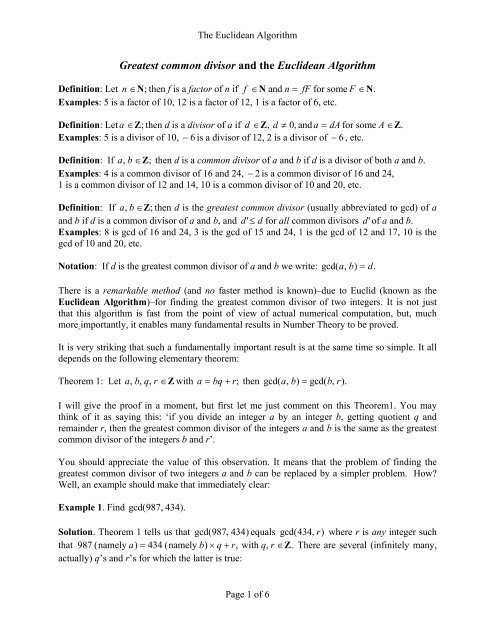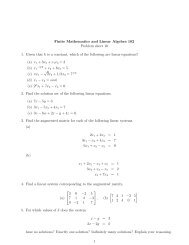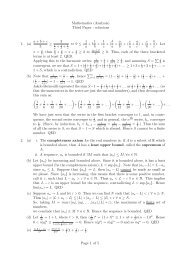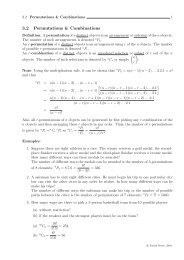Greatest common divisor and the Euclidean Algorithm. - DCU
Greatest common divisor and the Euclidean Algorithm. - DCU
Greatest common divisor and the Euclidean Algorithm. - DCU
Create successful ePaper yourself
Turn your PDF publications into a flip-book with our unique Google optimized e-Paper software.
The <strong>Euclidean</strong> <strong>Algorithm</strong><br />
<strong>Greatest</strong> <strong>common</strong> <strong>divisor</strong> <strong>and</strong> <strong>the</strong> <strong>Euclidean</strong> <strong>Algorithm</strong><br />
Definition: Let n ∈N; <strong>the</strong>n f is a factor of n if f ∈ N <strong>and</strong> n = fF for some F ∈N.<br />
Examples: 5 is a factor of 10, 12 is a factor of 12, 1 is a factor of 6, etc.<br />
Definition: Let a ∈Z; <strong>the</strong>n d is a <strong>divisor</strong> of a if d ∈Z, d ≠ 0, <strong>and</strong> a = dAfor some A ∈Z.<br />
Examples: 5 is a <strong>divisor</strong> of 10, − 6 is a <strong>divisor</strong> of 12, 2 is a <strong>divisor</strong> of − 6 , etc.<br />
Definition: If a, b∈Z;<br />
<strong>the</strong>n d is a <strong>common</strong> <strong>divisor</strong> of a <strong>and</strong> b if d is a <strong>divisor</strong> of both a <strong>and</strong> b.<br />
Examples: 4 is a <strong>common</strong> <strong>divisor</strong> of 16 <strong>and</strong> 24, − 2 is a <strong>common</strong> <strong>divisor</strong> of 16 <strong>and</strong> 24,<br />
1 is a <strong>common</strong> <strong>divisor</strong> of 12 <strong>and</strong> 14, 10 is a <strong>common</strong> <strong>divisor</strong> of 10 <strong>and</strong> 20, etc.<br />
Definition: If ab , ∈Z; <strong>the</strong>n d is <strong>the</strong> greatest <strong>common</strong> <strong>divisor</strong> (usually abbreviated to gcd) of a<br />
<strong>and</strong> b if d is a <strong>common</strong> <strong>divisor</strong> of a <strong>and</strong> b, <strong>and</strong> d'≤ d for all <strong>common</strong> <strong>divisor</strong>s d' of a <strong>and</strong> b.<br />
Examples: 8 is gcd of 16 <strong>and</strong> 24, 3 is <strong>the</strong> gcd of 15 <strong>and</strong> 24, 1 is <strong>the</strong> gcd of 12 <strong>and</strong> 17, 10 is <strong>the</strong><br />
gcd of 10 <strong>and</strong> 20, etc.<br />
Notation: If d is <strong>the</strong> greatest <strong>common</strong> <strong>divisor</strong> of a <strong>and</strong> b we write: gcd( a, b) = d.<br />
There is a remarkable method (<strong>and</strong> no faster method is known)–due to Euclid (known as <strong>the</strong><br />
<strong>Euclidean</strong> <strong>Algorithm</strong>)–for finding <strong>the</strong> greatest <strong>common</strong> <strong>divisor</strong> of two integers. It is not just<br />
that this algorithm is fast from <strong>the</strong> point of view of actual numerical computation, but, much<br />
more importantly, it enables many fundamental results in Number Theory to be proved.<br />
It is very striking that such a fundamentally important result is at <strong>the</strong> same time so simple. It all<br />
depends on <strong>the</strong> following elementary <strong>the</strong>orem:<br />
Theorem 1: Let<br />
a, b, q, r ∈Z with a = bq+ r; <strong>the</strong>n gcd( a, b) = gcd( b, r).<br />
I will give <strong>the</strong> proof in a moment, but first let me just comment on this Theorem1. You may<br />
think of it as saying this: ‘if you divide an integer a by an integer b, getting quotient q <strong>and</strong><br />
remainder r, <strong>the</strong>n <strong>the</strong> greatest <strong>common</strong> <strong>divisor</strong> of <strong>the</strong> integers a <strong>and</strong> b is <strong>the</strong> same as <strong>the</strong> greatest<br />
<strong>common</strong> <strong>divisor</strong> of <strong>the</strong> integers b <strong>and</strong> r’.<br />
You should appreciate <strong>the</strong> value of this observation. It means that <strong>the</strong> problem of finding <strong>the</strong><br />
greatest <strong>common</strong> <strong>divisor</strong> of two integers a <strong>and</strong> b can be replaced by a simpler problem. How<br />
Well, an example should make that immediately clear:<br />
Example 1. Find g cd( 987, 434).<br />
Solution. Theorem 1 tells us that gcd( 987, 434)<br />
equals gcd( 434, r)<br />
where r is any integer such<br />
that 987 ( namely a) = 434 ( namely<br />
b)<br />
× q+ r,<br />
with q, r∈Z . There are several (infinitely many,<br />
actually) q’s <strong>and</strong> r’s for which <strong>the</strong> latter is true:<br />
Page 1 of 6
The <strong>Euclidean</strong> <strong>Algorithm</strong><br />
987 = 434 .(-2)<br />
+ 1855,<br />
987 = 434 .(-1)<br />
+ 1421,<br />
987 = 434 .(0)<br />
+ 987,<br />
987 = 434 .(1)<br />
+ 553,<br />
987 = 434 .(2)<br />
+ 119, etc.<br />
The best of <strong>the</strong>se is 987 = 434.( 2) + 119,giving gcd( 987, 434) = gcd( 434, 119)<br />
. Then, reapplying<br />
Theorem1(434 = 119. 3 + 77)<br />
gives: gcd(434, 119) = gcd( 119, 77).<br />
<strong>and</strong> a fur<strong>the</strong>r use of<br />
Theorem 1( 119 = 771. + 42)<br />
- we get that: gcd( 119,<br />
77) = gcd( 77, 42).<br />
Continuing in this manner<br />
we get:<br />
gcd( 987, 434) = gcd( 434, 119) = gcd( 119, 77) = gcd( 77, 42) = gcd( 42, 35) = gcd( 35,<br />
7)<br />
= 7.<br />
It means that we have been able to calculate <strong>the</strong> greatest <strong>common</strong> <strong>divisor</strong> of two integers without<br />
having to find <strong>the</strong> actual <strong>divisor</strong>s of ei<strong>the</strong>r of <strong>the</strong>m. The crucial thing is that at each stage <strong>the</strong><br />
problem of finding <strong>the</strong> greatest <strong>common</strong> <strong>divisor</strong> of two integers was replaced by <strong>the</strong> simpler<br />
problem of finding <strong>the</strong> greatest <strong>common</strong> <strong>divisor</strong> of two o<strong>the</strong>r integers, <strong>the</strong> larger of which is <strong>the</strong><br />
least of <strong>the</strong> previous two.<br />
It is <strong>the</strong> application of Theorem1, <strong>and</strong> its repeated application, that constitutes what is called <strong>the</strong><br />
<strong>Euclidean</strong> <strong>Algorithm</strong>. We must first, however, prove that Theorem1. It is simple:<br />
Proof of Theorem1. Let<br />
gcd( a, b)<br />
= d 1<br />
<strong>and</strong> gcd( br , ) = d 2<br />
. (We want to prove that d<br />
= d .)<br />
1 2<br />
Since d 1<br />
is a <strong>common</strong> <strong>divisor</strong> of a <strong>and</strong> b <strong>the</strong>n a = d1A<strong>and</strong> b=<br />
d1Bfor some AB , ∈Z, <strong>and</strong> so we<br />
have (from a = bq+ r) that dA<br />
1<br />
= ( dBq<br />
1<br />
) + r, <strong>and</strong> thus r = d1A− ( d1B) q = d1( A−<br />
Bq).<br />
Thus d 1<br />
is<br />
a <strong>divisor</strong> of r because ( A−<br />
Bq) ∈Z,<br />
<strong>and</strong>, since d 1<br />
is a <strong>divisor</strong> of b, it follows that d 1<br />
is a <strong>common</strong><br />
<strong>divisor</strong> of b <strong>and</strong> r. Therefore d ≤ d . ... (i)<br />
1 2<br />
Also, d 2<br />
is a <strong>common</strong> <strong>divisor</strong> of b <strong>and</strong> r, <strong>and</strong> so b= d2 B<strong>and</strong> r = d2 R,<br />
for some B, R∈Z,<br />
<strong>and</strong> so<br />
we have (from a = bq+ r) that a = ( d2 B)<br />
q+<br />
d2R,<br />
<strong>and</strong> so a = d2( Bq+<br />
R). Thus d 2<br />
is a <strong>divisor</strong> of<br />
a because(Bq + R) ∈Z,<br />
<strong>and</strong>, since d 2<br />
is a <strong>divisor</strong> of b, it now follows that d 2<br />
is a <strong>common</strong> <strong>divisor</strong><br />
of a <strong>and</strong> b. Therefore d2 ≤ d1.<br />
... (ii)<br />
Between <strong>the</strong>m, (i) <strong>and</strong> (ii) now give that d<br />
= d , <strong>and</strong> so gcd( a, b) = gcd( b, r).<br />
(end of proof.)<br />
1 2<br />
Easy Yes, it is. Nothing could be simpler, <strong>and</strong> yet it very quickly leads to very important<br />
conclusions (I cannot think of anything that is so simple, but yet so important).<br />
Note. In fact, not only is Theorem 1 true - namely that <strong>the</strong> greatest <strong>common</strong> <strong>divisor</strong> of a <strong>and</strong> b is<br />
equal to <strong>the</strong> greatest <strong>common</strong> <strong>divisor</strong> of b <strong>and</strong> r (given, of course, that a = bq+ r)<br />
– but <strong>the</strong><br />
Page 2 of 6
The <strong>Euclidean</strong> <strong>Algorithm</strong><br />
following is in fact true: every <strong>common</strong> <strong>divisor</strong> of a <strong>and</strong> b is a <strong>common</strong> <strong>divisor</strong> of b <strong>and</strong> r, <strong>and</strong><br />
vice versa. That is:<br />
Theorem 2: Let a, b, q, r ∈Z with a = bq+ r, <strong>and</strong> let S 1<br />
be <strong>the</strong> set of all <strong>common</strong> <strong>divisor</strong>s of a<br />
<strong>and</strong> b, <strong>and</strong> S 2<br />
be <strong>the</strong> set of all <strong>common</strong> <strong>divisor</strong>s of b <strong>and</strong> r; <strong>the</strong>n S = S .<br />
1 2<br />
[I give a proof of this at <strong>the</strong> end of <strong>the</strong>se notes; it is almost identical to <strong>the</strong> proof of Theorem 1.]<br />
Now we are going to see how Theorem 1 leads to being able to find <strong>the</strong> greatest <strong>common</strong> <strong>divisor</strong><br />
of any two integers. We will suppose from now on that b > 0, <strong>and</strong> look first at <strong>the</strong> simplest case,<br />
namely <strong>the</strong> case where ba . Here we immediately have that gcd( a, b) = b.<br />
Next we look at what happens when b a /| . Here we choose <strong>the</strong> remainder r so that:<br />
1<br />
a = bq1 + r1<br />
, <strong>and</strong> 0 < r1<br />
≤ ( b −1),<br />
q1<br />
∈ Z.<br />
Now we have that gcd( a, b) gcd( b, r ), <strong>and</strong> now we do with b <strong>and</strong> what we just did with a<br />
=<br />
1<br />
<strong>and</strong> b, namely divide b by r 1<br />
. Why do we do this Well, if r1 b <strong>the</strong>n gcd( br ,<br />
1<br />
) = r 1<br />
, <strong>and</strong> so <strong>the</strong><br />
value of g cd( a, b)<br />
would immediately be found from:<br />
gcd( a, b) = gcd( b, r ) = r.<br />
But, if r1 /| b, <strong>and</strong> we choose <strong>the</strong> remainder r 2<br />
so that:<br />
1 1<br />
b = rq + r , <strong>and</strong> 0< r ≤ ( r −1),<br />
q ∈Z,<br />
1 2 2 2 1 2<br />
we <strong>the</strong>n have gcd( ab , ) = gcd( br , ) = gcd( r, r).<br />
1 1<br />
2<br />
r 1<br />
Then <strong>the</strong> problem is: what is <strong>the</strong> value of gcd( r1, r2)<br />
Again, if r2 r <strong>the</strong>n gcd( r <strong>and</strong> so<br />
1<br />
1, r2) = r2,<br />
<strong>the</strong> value of gcd( a, b)<br />
would immediately be found from:<br />
gcd( ab , ) = gcd( br , ) = gcd( r, r) = r.<br />
1 1 2 2<br />
If, however,<br />
r<br />
/| r,<br />
2 1<br />
<strong>the</strong>n we continue as above, <strong>and</strong> perform yet ano<strong>the</strong>r division:<br />
r = r q + r , <strong>and</strong> 0< r ≤ ( r −1),<br />
q ∈Z,<br />
1 2 3 3 3 2 3<br />
<strong>and</strong> - if necessary - perform several more similar divisions:<br />
r2 = rq<br />
3 4<br />
+ r4, <strong>and</strong> 0< r4 ≤ ( r3 −1),<br />
q4<br />
∈Z,<br />
r3 = r4q5 + r5, <strong>and</strong> 0< r5 ≤ ( r4 −1),<br />
q5<br />
∈Z,<br />
...<br />
Page 3 of 6
The <strong>Euclidean</strong> <strong>Algorithm</strong><br />
with gcd( a, b) = gcd( b, r ) = gcd( r, r ) = gcd( r , r ) = gcd( r , r ) = gcd( r , r ) =<br />
1 1 2 2 3 3 4 4 5<br />
K<br />
This sequence of equations cannot continue indefinitely. Why Because ‘a decreasing sequence<br />
of positive integers must have a least member’. (This is sometimes referred to as <strong>the</strong><br />
Fundamental Property of <strong>the</strong> Natural Numbers’). Here <strong>the</strong> decreasing sequence is r, r , r ,K .<br />
1 2 3<br />
Thus we must eventually arrive at some remainder<br />
r n<br />
such that<br />
rn<br />
rn−1 , <strong>and</strong> so we end up with:<br />
rn−3 = rn−2qn− 1<br />
+ rn− 1, <strong>and</strong> 0< rn− 1<br />
≤ ( rn−2 −1),<br />
qn−<br />
1<br />
∈Z,<br />
rn−2 = rn− 1qn + rn, <strong>and</strong> 0< rn ≤ ( rn−<br />
1<br />
−1),<br />
qn<br />
∈Z,<br />
r = r q , with q ∈ Z . (<strong>and</strong> thus gcd( r , r ) = r .)<br />
n− 1 n n+ 1 n+ 1 n−1<br />
n n<br />
Finally we have: gcd( a, b) = gcd( b, r ) = K = gcd( r , r ) = r , <strong>and</strong> thus: gcd( a, b) = .<br />
1 n−1<br />
n n<br />
That last equation is of fundamental importance as it enables us to calculate - with incredible<br />
speed - <strong>the</strong> greatest <strong>common</strong> <strong>divisor</strong> of any two integers without having to calculate any<br />
<strong>common</strong> <strong>divisor</strong>s at all!! It is a remarkable method due to Euclid (~ 300B.C.), <strong>and</strong> is rightly<br />
considered to be one of <strong>the</strong> very best algorithms (an algorithm - roughly speaking - is a set of<br />
instructions for carrying out a given calculation).<br />
You should do - by h<strong>and</strong> - several worked examples of finding <strong>the</strong> greatest <strong>common</strong> <strong>divisor</strong> of<br />
two integers; examples like:<br />
Find, using <strong>the</strong> <strong>Euclidean</strong> <strong>Algorithm</strong>, g cd( 987, 345), gcd( 12321, 337), gcd( 97, 47),<br />
etc.<br />
Note. Maple has an in-built comm<strong>and</strong> for calculating <strong>the</strong> gcd of any two integers; it is igcd(a,<br />
b). This comm<strong>and</strong> (igcd for calculating <strong>the</strong> gcd of two integers) happens to be one of a very<br />
small number whose Maple code cannot be accessed using <strong>the</strong> interface(verboseproc=2)<br />
(followed by print(igcd)) facility, but you will see in Maple lab classes a simple Maple<br />
procedure for calculating <strong>the</strong> gcd of any two integers.<br />
Ano<strong>the</strong>r very important related Maple comm<strong>and</strong>. There is a related comm<strong>and</strong> igcdex, which<br />
expresses <strong>the</strong> gcd of two integers as an ‘integral linear combination’ of those integers. That is<br />
<strong>the</strong> subject of ano<strong>the</strong>r set of notes.<br />
Proof of Theorem 2. Let f1 ∈S1 <strong>and</strong> f2<br />
∈S2. (We will prove that f1 ∈S2 <strong>and</strong> f2 ∈S1, <strong>and</strong> so it<br />
will follow that S1 = S2.) Since f1 ∈ S1<br />
<strong>the</strong>n a = f1A<strong>and</strong> b=<br />
f1Bfor some AB , ∈Z, <strong>and</strong> so we<br />
have (from a = bq+ r) that fA<br />
1<br />
= ( fBq<br />
1<br />
) + r, <strong>and</strong> thus r = f1A− ( f1B) q = f1( A−<br />
Bq).<br />
Thus f 1<br />
is a<br />
<strong>divisor</strong> of r because ( A− B q) ∈Z,<br />
<strong>and</strong>, since f1<br />
is a <strong>divisor</strong> of b, it follows that f 1<br />
is a <strong>common</strong><br />
<strong>divisor</strong> of b <strong>and</strong> r. Thus every <strong>common</strong> <strong>divisor</strong> of a <strong>and</strong> b is also a <strong>common</strong> <strong>divisor</strong> of b <strong>and</strong> r,<br />
i.e. f<br />
∈ S . ... (i)<br />
1 2<br />
r n<br />
Page 4 of 6
The <strong>Euclidean</strong> <strong>Algorithm</strong><br />
Also, since f2 ∈S2<br />
<strong>the</strong>n b= f2 B' <strong>and</strong> r = f2R,<br />
for some B', R∈Z,<br />
<strong>and</strong> so we have (again<br />
from a = b q+ r) that a = ( f2B') q+<br />
f2R,<br />
<strong>and</strong> so a = f2( B' q+<br />
R). Thus f 2<br />
is a <strong>divisor</strong> of a<br />
because( Bq ' + R)<br />
∈Z, <strong>and</strong>, since f 2<br />
is a <strong>divisor</strong> of b, it now follows that f2<br />
is a <strong>common</strong> <strong>divisor</strong><br />
of a <strong>and</strong> b. Thus every <strong>common</strong> <strong>divisor</strong> of b <strong>and</strong> r is also a <strong>common</strong> <strong>divisor</strong> of a <strong>and</strong> b,<br />
i.e. f<br />
∈ S . ... (ii)<br />
2 1<br />
Between <strong>the</strong>m, (i) <strong>and</strong> (ii) now give that S1 = S2. (end of proof.)<br />
____________________<br />
The usual formal statement of <strong>the</strong> ‘<strong>Euclidean</strong> <strong>Algorithm</strong>’ is this: Let ab , ∈Z with b > 0.<br />
1 1 2 2 K n n n+1<br />
If ba<strong>the</strong>n gcd( ab , ) = d;<br />
o<strong>the</strong>rwise <strong>the</strong>re are integers q , r , q , r , , q , r , q such that:<br />
a = bq1 + r1, 0< r1<br />
≤ ( b−<br />
1),<br />
b = rq 1 2 + r2, 0< r2 ≤ ( r1<br />
− 1),<br />
r1 = r2q3 + r3, 0< r3 ≤ ( r2<br />
− 1),<br />
.<br />
.<br />
rn−3 = rn−2qn−1 + rn−1, 0< rn−1 ≤ ( rn−2<br />
− 1),<br />
rn−2 = rn−1qn + rn, 0< rn ≤ ( rn−1<br />
− 1),<br />
rn− 1 = rnqn+<br />
1,<br />
<strong>and</strong> gcd( ab , ) = r n .<br />
__________<br />
Page 5 of 6








